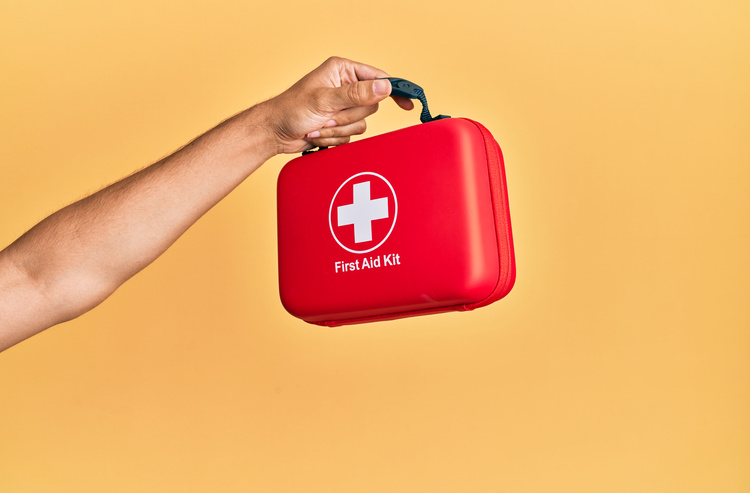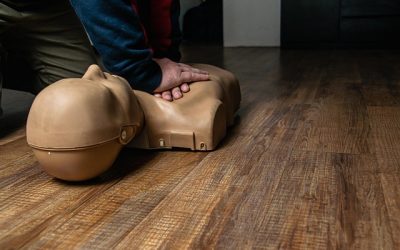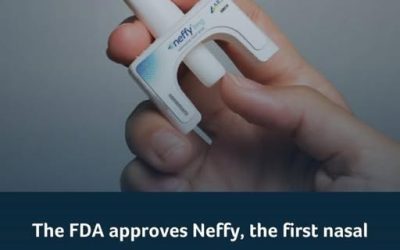It is the legal responsibility of UK business owners to provide their employees with access to first aid tools and equipment, per the Health and Safety (First-Aid) Regulations, 1981. This ensures that employees can take immediate action in an emergency. Furthermore, a well-stocked first aid kit will enhance your safety efforts and provide you with much greater peace of mind moving forward.
Not sure what to include in your first aid kit? Don’t worry. At JMS First Aid, we have years of experience supporting local business owners as they work to protect their employees and their business. Read on to find out more!
What Should Be in a First Aid Kit at Work?
According to the latest HSE guidelines, the following first aid box requirements should be met when creating a basic kit for your workplace.
HSE FIRST AID KIT LIST
- Sterile dressings
- Sterile bandages
- Sterile eye pads
- Wound dressings
- Plasters (individually wrapped)
- Safety pins
- Disposable gloves
However, you may also want to include some of the following as standard.
- Waterproof plasters
- A face shield/mask
- Antiseptic wipes
- Adhesive tape
The number of first aid kits you should have within easy access to your employees can vary depending on a variety of circumstances, such as the size of your business premises or the number of employees on-site. All kits should contain a leaflet that discusses basic safety practices and protocols, such as how to give first aid to someone in need.
Ideally, these items should be replenished as quickly as possible after use. However, you should also periodically check your first aid kit to make sure that it is fully stocked. This way, you are not running the risk of going without something when you need it most. This is a task that you can assign to your health and safety officer, and it should not take up too much of their time to routinely check your kits.
Additional Items to Consider for Your Workplace
While the above list is a great starting point when it comes to putting together a workplace first aid kit, you may find that you need additional items depending on the nature of your business and the specific risks you may encounter.
First Aid Kit Essentials For Warehouses.
- A leaflet outlining first aid practices typically adopted in warehouses or factory environments
- Saline solution
- Burn dressings
- Eyewash
- Foil blankets
- PPE
- Defibrillator and resuscitation tools
First Aid Kit Essentials For Schools.
- A leaflet discussing the basics of paediatric first aid
- Washproof plasters
- Ice or cold packs
- Disposable aprons
- Defibrillator and resuscitation tools
Generally speaking, you’ll be able to identify the tools and equipment you need to keep anyone on your business premises safe through routine risk assessments. This is because you’ll be more aware of the injuries you are most likely to deal with, allowing you to stock your kit accordingly.
Legal Requirements: Employer Duties and HSE Guidelines
As an employer, providing your employees with access to a first aid kit is a legal requirement. It is covered in UK workplace first aid regulations, such as the Health and Safety (First-Aid) Regulations (1981).
This legislation states that:
An employer shall provide, or ensure that there are provided, such equipment and facilities as are adequate and appropriate in the circumstances for enabling first-aid to be rendered to his employees if they are injured or become ill at work.
Other relevant employer responsibilities covered by HSE legislation are built around maintaining a safe workspace for all, conducting regular risk assessments, and ensuring that first-aid kits are regularly restocked.
Common Questions About Workplace First Aid Kits
Do first aid kits have to be green?
While first aid kits do not have to be green, this is often considered to be the universal colour of a first aid kit. This means that it’s easy for employees/users to spot in an emergency, as they know ahead of time what to look for.
How often should a first aid kit be checked?
As a general rule, you should aim to replenish items in the first aid kit as soon as they have been used. However, you should check your kits every few months to ensure you have access to everything you may need. Don’t wait until an emergency to realise something is missing!
Can you have painkillers in a work first aid kit?
While having access to painkillers may seem like a great idea, it is generally recommended that you do not include them in your first aid kit. This is because administering pain medication is not covered by standard first aid protocols and practices. It is typically considered to be something that employees can supply themselves if deemed necessary.
There are some exceptions to this rule. For example, aspirin can be included in first aid kits for use in the case of a suspected heart attack.
What is not allowed in a workplace first aid kit?
Generally speaking, you should avoid placing sharps or other hazardous equipment in a first aid kit. You should also make sure that you check the expiration dates of products.
How JMS First Aid Helps Northampton Businesses Stay Compliant
Looking to improve your workplace safety protocols? We’re here to help!
At JMS First Aid, we have years of experience supporting business owners who want to put the best interests of their employees first. From our base in Northampton, we offer a range of services, including First Aid training, workplace assessments, and guidance on first aid kit selection.
This ensures that your safety protocols are as up-to-date as possible, protecting your business, employees and anyone else who may be present on-site.
Our courses are designed to support businesses across all industries, whether you’re looking for an introductory course or a refresher. We also run specialist first aid courses covering automatic external defibrillator training and more.
If you’d like to find out more or want to schedule a workplace assessment, please do not hesitate to get in touch today.
Conclusion: Take Action – Ensure Your Workplace Is Prepared
When an employee is injured or gets ill at work, it is important that those around them can act quickly. This often means that they’ll need access to a full-stocked first aid kit, so that they can render first aid.
As such, maintaining a full kit (and upholding safety procedures) should be the #1 priority of business owners, HR managers and individual employees moving forward.
Enrol in a training course today to take your practices to the next level!




